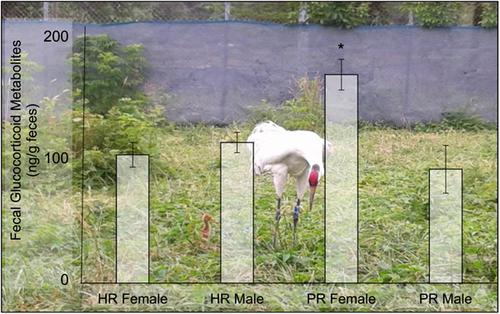Our official English website, www.x-mol.net, welcomes your
feedback! (Note: you will need to create a separate account there.)
Comparison of fecal glucocorticoid metabolite concentrations in hand- versus parent-reared whooping cranes (Grus americana )
Zoo Biology ( IF 1.2 ) Pub Date : 2020-04-08 , DOI: 10.1002/zoo.21541 Megan E Brown 1 , Miranda R Torkelson 2 , Glenn H Olsen 3 , Ashley Krisp 2 , Barry K Hartup 2, 4
Zoo Biology ( IF 1.2 ) Pub Date : 2020-04-08 , DOI: 10.1002/zoo.21541 Megan E Brown 1 , Miranda R Torkelson 2 , Glenn H Olsen 3 , Ashley Krisp 2 , Barry K Hartup 2, 4
Affiliation

|
Endangered whooping cranes (Grus americana) have been produced in captivity for reintroduction programs since the 1980s, using techniques such as artificial insemination, multiple clutching, and captive-rearing to speed recovery efforts. Chicks are often hand-reared (HR) by caretakers in crane costumes, socialized into groups and released together, unlike parent-reared (PR) cranes that are raised individually by a male/female crane pair and released singly. HR cranes historically exhibit greater morbidity rates during development than PR cranes, involving musculoskeletal and respiratory system disease, among others. We hypothesized that HR crane chicks exhibit a higher baseline fecal glucocorticoid metabolite (FGM) concentrations during the development compared with PR chicks. Fecal samples were collected between 15 and 70 days of age from HR (n = 15) and PR (n = 8) chicks to test for differences in FGM concentrations using a radioimmunoassay technique following ethanol extraction for steroids. Linear mixed model analysis suggests increasing age of the chick was associated with an increase in FGM (p < .001). Analysis also supported the interaction between rearing strategy and sex of the crane chick (p < .01). Female PR chicks had greater FGM concentrations than all other groups (PR male, p < .01; HR female, p < .001; and HR male, p < .001). This result suggests that there may be an effect of rearing strategy on stress physiology of whooping crane chicks, especially among females. Further research is needed to investigate whether the FGM concentrations are reflective of true differences in stress physiology of young cranes and whether this may impact health and conservation success.
中文翻译:

人工饲养与亲本饲养的百日鹤(美洲鹤)粪便糖皮质激素代谢物浓度的比较
自 1980 年代以来,濒临灭绝的美洲鹤(Grus americana)已被圈养,用于重新引入计划,使用人工授精、多抓和圈养饲养等技术来加快恢复工作。雏鸟通常由穿着鹤服装的看护人人工饲养 (HR),分组社会化并一起释放,这与由雄性/雌性鹤对单独饲养并单独释放的亲代 (PR) 鹤不同。历史上,HR 起重机在开发过程中表现出比 PR 起重机更高的发病率,包括肌肉骨骼和呼吸系统疾病等。我们假设与 PR 雏鸡相比,HR 鹤雏鸡在发育过程中表现出更高的基线粪便糖皮质激素代谢物 (FGM) 浓度。从 HR (n = 15) 和 PR (n = 8) 雏鸡 15 到 70 日龄之间收集粪便样本,以在乙醇提取类固醇后使用放射免疫分析技术测试 FGM 浓度的差异。线性混合模型分析表明,雏鸡年龄的增加与 FGM 的增加有关(p < .001)。分析还支持饲养策略与鹤雏性别之间的相互作用(p < .01)。雌性 PR 雏鸡的 FGM 浓度高于所有其他组(PR 雄性,p < .01;HR 雌性,p < .001;HR 雄性,p < .001)。这一结果表明,饲养策略可能对百日鹤雏鸡的应激生理有影响,尤其是在雌性中。
更新日期:2020-04-08
中文翻译:

人工饲养与亲本饲养的百日鹤(美洲鹤)粪便糖皮质激素代谢物浓度的比较
自 1980 年代以来,濒临灭绝的美洲鹤(Grus americana)已被圈养,用于重新引入计划,使用人工授精、多抓和圈养饲养等技术来加快恢复工作。雏鸟通常由穿着鹤服装的看护人人工饲养 (HR),分组社会化并一起释放,这与由雄性/雌性鹤对单独饲养并单独释放的亲代 (PR) 鹤不同。历史上,HR 起重机在开发过程中表现出比 PR 起重机更高的发病率,包括肌肉骨骼和呼吸系统疾病等。我们假设与 PR 雏鸡相比,HR 鹤雏鸡在发育过程中表现出更高的基线粪便糖皮质激素代谢物 (FGM) 浓度。从 HR (n = 15) 和 PR (n = 8) 雏鸡 15 到 70 日龄之间收集粪便样本,以在乙醇提取类固醇后使用放射免疫分析技术测试 FGM 浓度的差异。线性混合模型分析表明,雏鸡年龄的增加与 FGM 的增加有关(p < .001)。分析还支持饲养策略与鹤雏性别之间的相互作用(p < .01)。雌性 PR 雏鸡的 FGM 浓度高于所有其他组(PR 雄性,p < .01;HR 雌性,p < .001;HR 雄性,p < .001)。这一结果表明,饲养策略可能对百日鹤雏鸡的应激生理有影响,尤其是在雌性中。









































 京公网安备 11010802027423号
京公网安备 11010802027423号